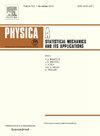Line graph neural networks for link weight prediction
IF 2.8
3区 物理与天体物理
Q2 PHYSICS, MULTIDISCIPLINARY
Physica A: Statistical Mechanics and its Applications
Pub Date : 2025-01-29
DOI:10.1016/j.physa.2025.130406
引用次数: 0
Abstract
In real-world networks, predicting the weight (strength) of links is as crucial as predicting the existence of the links themselves. Previous studies have primarily used shallow graph features for link weight prediction, limiting the prediction performance. In this paper, we propose a new link weight prediction method, namely Line Graph Neural Networks for Link Weight Prediction (LGLWP), which learns intrinsic graph features through deep learning. In our method, we first extract the enclosing subgraph around a target link and then employ a weighted graph labeling algorithm to label the subgraph nodes. Next, we transform the subgraph into the line graph and apply graph convolutional neural networks to learn the node embeddings in the line graph, which can represent the links in the original subgraph. Finally, the node embeddings are fed into a fully-connected neural network to predict the weight of the target link, treated as a regression problem. Our method directly learns link features, surpassing previous methods that splice node features for link weight prediction. Experimental results on six network datasets of various sizes and types demonstrate that our method outperforms state-of-the-art methods.
求助全文
约1分钟内获得全文
求助全文
来源期刊
CiteScore
7.20
自引率
9.10%
发文量
852
审稿时长
6.6 months
期刊介绍:
Physica A: Statistical Mechanics and its Applications
Recognized by the European Physical Society
Physica A publishes research in the field of statistical mechanics and its applications.
Statistical mechanics sets out to explain the behaviour of macroscopic systems by studying the statistical properties of their microscopic constituents.
Applications of the techniques of statistical mechanics are widespread, and include: applications to physical systems such as solids, liquids and gases; applications to chemical and biological systems (colloids, interfaces, complex fluids, polymers and biopolymers, cell physics); and other interdisciplinary applications to for instance biological, economical and sociological systems.

 求助内容:
求助内容: 应助结果提醒方式:
应助结果提醒方式:


